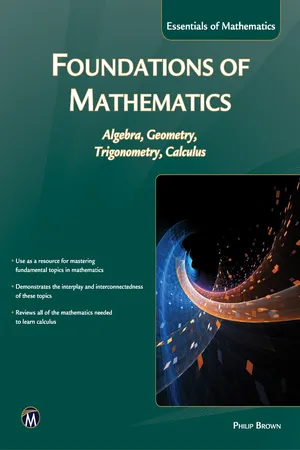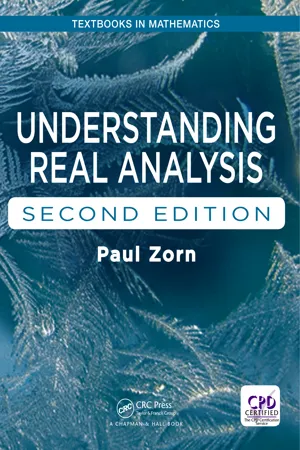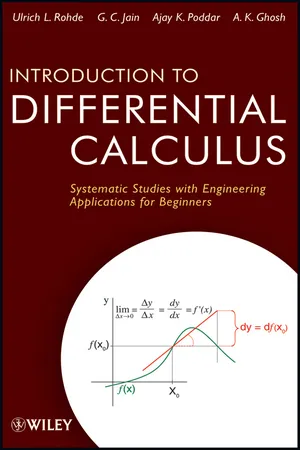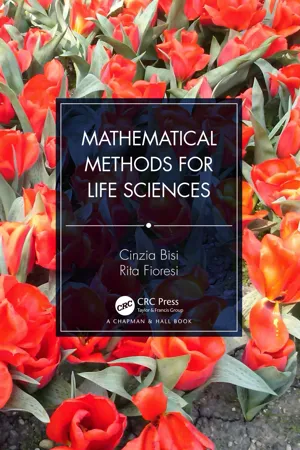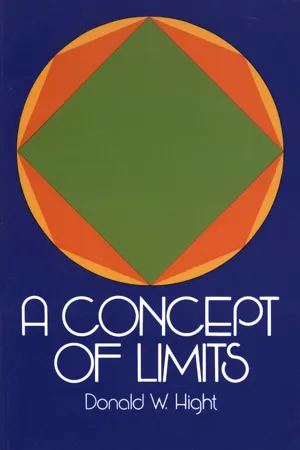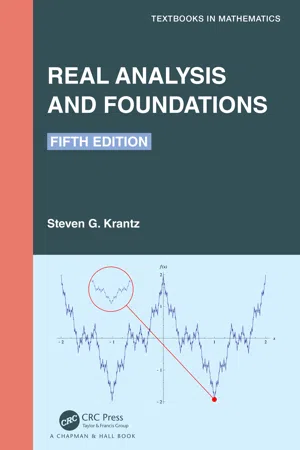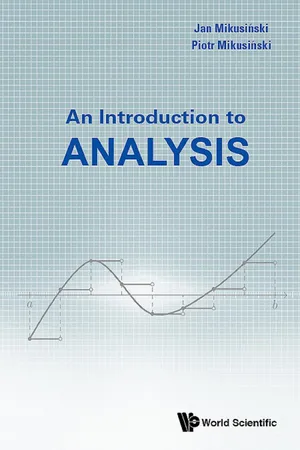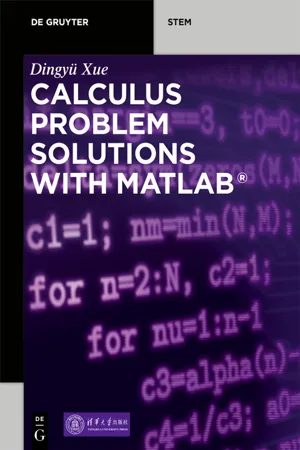Mathematics
Limits of a Function
In mathematics, the limit of a function describes the behavior of the function as the input approaches a certain value. It represents the value that the function approaches as the input gets closer and closer to the specified value. Limits are fundamental in calculus and are used to define continuity, derivatives, and integrals.
Written by Perlego with AI-assistance
Related key terms
Related key terms
1 of 4
Related key terms
1 of 3
10 Key excerpts on "Limits of a Function"
- eBook - ePub
Foundations of Mathematics
Algebra, Geometry, Trigonometry and Calculus
- Philip Brown(Author)
- 2016(Publication Date)
- Mercury Learning and Information(Publisher)
7LIMITS
7.1INTRODUCTION
The concept of a limiting value of a function plays an important role in calculus, because the formal definition of the derivative of a function at a point in its domain can be expressed as the limiting value of a particular expression involving the function.The meaning of “limit” in mathematics is more subtle than that in everyday speech. A speed limit that applies on a highway is a speed that motorists may not exceed. The meaning of “limit” in mathematics is similar to that in the following sentence: “In the minute to win it competition the contestant was pushed to the limit of his abilities.” Thus, a “limit” in mathematics is something (like a number or geometrical figure) that is approached and might or might not be reached.It is in keeping with the historical approach of this book to begin with the method of exhaustion as an example of an occurrence of a limit in mathematics, as this is the method that Archimedes and other Greek mathematicians of his time used to calculate approximate values of certain areas, for example, the area of a disk. In section 7.3 , the concept of a limit is explained carefully using number sequences without giving the completely rigorous treatment (involving ε arguments) that are given in more advanced textbooks. Students of this book will probably not benefit from such a theoretical approach at this stage.The notion of the left or right limit of a function, introduced simplistically (by reading from a graph) in section 7.4 , leads to the definition of continuity of a function in section 7.5 . The property of continuity is important because many theorems about functions, for example, the Intermediate Value Theorem (in section 7.7 ), apply only to functions that are continuous.Most of the skills that students need to learn in this chapter are introduced in sections 7.6 and 7.8 - eBook - ePub
- Paul Zorn(Author)
- 2017(Publication Date)
- Chapman and Hall/CRC(Publisher)
CHAPTER 3Limits and Continuity
3.1 Limits of FunctionsThis chapter is about continuous functions and their properties. As a foretaste, consider this reasonable‐sounding claim about a function f :If f ( - 1) = - 2 and f (1) = 5, then f (a ) = 0 for some a ∊ ( - 1, 1) .Is this true? If a graph passes through the pointsand( - 1 , - 2 ), must it also cross the x -axis somewhere in between? Must there also be an input b with f (b ) = π ?( 1 , 5 )Both answers turn out to be “yes”—if the function f is continuous everywhere along the input interval [−1, 1]. In this case, answers follow from the famous intermediate value theorem , which we will carefully state and prove later in this chapter. To prove such results we’ll draw on earlier work with completeness, suprema and infima, limits, the Bolzano–Weierstrass theorem, and more. Our work starts, as usual, with clear definitions of words like “limit” (as applied to functions) and “continuous.”The IV theorem says that the range of a continuous function has no “gaps”; details come later.Defining Limits of Functions
Most of us emerge from elementary calculus courses with a rough and ready view of function limits. To say that limx →3f (x ) = 5, for example, means something like f (x ) approaches 5 as x approaches 3, or f (x ) ≈ 5 when x ≈ 3.These views are not incorrect, but they are too vague to be useful for building theory or proving theorems. What exactly does “approaches” mean? How close to 3 must x be for x ≈ 3 to hold? We need a precise definition.Definition 3.1 (Limit of a function). Let f be a function whose domain includes an open interval I containing a , except perhaps for x = a . Let L be a number. We writeObserve, right away, two important subtleties about domains:if, for every ɛ > 0, there exists δ > 0 such that |f (x ) - L | < ɛ whenever x ∊ I and 0 < |x - a | < δ .limf( x )= L• At x = a : The value f (a ) itself need not be defined for the limit to exist at x = a . Indeed, the whole point of finding such a limit is often to do with a “missing” or mysterious function value. If f (a ) is defined, that’s fine, but it’s irrelevant to the definition, which avoids all mention of f (a - eBook - ePub
Introduction to Differential Calculus
Systematic Studies with Engineering Applications for Beginners
- Ulrich L. Rohde, G. C. Jain, Ajay K. Poddar, A. K. Ghosh(Authors)
- 2012(Publication Date)
- Wiley(Publisher)
Chapter 7a The Concept of Limit of a Function 7a.1 IntroductionAddition, subtraction, multiplication, division, raising to a power, extracting a root, taking a logarithm, or a modulus are operations of elementary mathematics. In order to pass from elementary mathematics to higher mathematics, we must add to this list one more mathematical operation, namely, “finding the limit of a function ”.The notion of limit is an important new idea that lies at the foundation of Calculus. In fact, we might define Calculus as the study of limits. It is, therefore, important that we have a deep understanding of this concept. Although the topic of limit is rather theoretical in nature, we shall try to represent it in a very simple and concrete way.7a.2 Useful Notations Our work for understanding the concept of limit will be simplified if we use certain notations. Therefore, let us first get familiar with these notations:- Meaning of the notation x → a:
Let x be a variable and “a ” be a constant. If x assumes values nearer and nearer to “a ” (without assuming the value “a ” itself), then we say x tends to a (or x approaches a ) and we write x → a . In other words, the procedure of giving values to x (from the domain of “f ”) nearer and nearer to “a ”, but not permitting x to assume the value “a ”, is denoted by the symbol “x → a ”.Thus, x → 1 means, we assign values to x which are nearer and nearer to 1 (but not permitting x to assume the value 1), which means that x comes closer and closer to “1”, reducing the distance between “x ” and “1”, in the process.Thus, by the statement “x ” tends to “a ”, we mean that:i. x ≠ a ,ii. x assumes values nearer and nearer to a , andiii. The way in which x should approach a is not specified.(Different ways of approaching “a ” are given below.)
- Meaning of x → a −
If we consider x to be approaching closer and closer to “a ” from the left side (i.e., through the values less than “a ”), then we denote this procedure by writing x →a − and read it as “x” tends to “a minus
- eBook - ePub
- Cinzia Bisi, Rita Fioresi(Authors)
- 2024(Publication Date)
- Chapman and Hall/CRC(Publisher)
2 Limits and DerivativesDOI: 10.1201/9781003343288-22.1 Limits
The concept of limit represents the foundation of differential and integral calculus: it tells us how the value f(x) of a function f changes as the variable x approaches a value x0 .For example, consider the linear function f(x) = x + 3. We see that f(x) approximates the number 5, as x approaches the value x0 = 2. We can easily see it, if we substitute the value 2 for x: f(2) = 2 + 3 = 5 and we look at the graph of the line y = x + 3. Indeed, for values of x close to the point x0 = 2 on the x-axis, the corresponding values of the function f are very close to f(2) = 5.x f(x) 2 5 2.1 5.1 1.9 4.9 As we shall see, we need the definition of limit to understand the values of the function f at x “near” x0 , when we cannot evaluate the function f at x0 .Definition 2.1.1 Let f : D → ℝ and suppose that f is defined at all points of an open interval containing x0 , but not necessarily in x0 . We say that the real number L is the limit of f(x) for x approaching x0 , if, for every ε > 0, there exists δ > 0 such that, if 0 < |x − x0 | < δ, we have:| f ( x ) − L | < ϵWe write in formulas:limf ( x ) = Lx →x 0Let us see an example.Example 2.1.2 We want to check that the limit of the function f(x) = x + 3, for x approaching 2, is equal to 5, as we intuitively anticipated at the beginning of this section:limx + 3 = 5x → 2We must show that, for any number ε > 0, we can always find a number δ > 0, such that if 0 < |x − 2| < δ, then |x + 3 − 5| < ε. Let us start by examining the last inequality:| x − 2 | < ϵ ⇔ 2 − ϵ < x < 2 + ϵSo if δ = ε, we have 0 < |x − 2| < δ.We invite the reader to check by exercise, using the reasoning of the previous example, that:(2.1)limx =x →x 0x 0,limk = kx →x 0where k ∈ ℝ is a constant.We can also define the right-hand limit and the left-hand limit of a function at x0 .- Right-hand limit: We define lim x
- eBook - ePub
The Learning and Teaching of Calculus
Ideas, Insights and Activities
- John Monaghan, Robert Ely, Márcia M.F. Pinto, Mike Thomas(Authors)
- 2023(Publication Date)
- Routledge(Publisher)
a and, again, must be an accumulation point of the function’s domain.How do teachers and students understand this notation? Does the teacher think the notation makes the definition more rigorous that the informal definition, algebraically operational, or is it just a shorthand? We do not see anything wrong with this definition as a means of getting an idea across to a group of students, but it is useful for us, as teachers, to appreciate that it is not the formal definition. We also draw readers’ attention to the mathematics education research, presented in Section 3.2 , on students’ understanding of terms such as ‘approaches’; it is thus important that teachers dwell on what the mathematical use of such words means.We now move from defining limits to properties of limits. There are three properties of limits that you may or may not consider relevant in your calculus course: the uniqueness of a limit, the existence of a limit when the limit point is not even defined and the non-existence of a limit.- Property 1: If the f(x)exists, then it is uniquelimf ( x )x → a
Justification: Suppose we assign two different values tof(x), say, c and d, where |c – d| > O. By definition, a real function relates one in the domain, to just one f(x) in the function’s range. So, it is impossible to preserve closeness around both positions c and d when x is within any degree of accuracy a.limf ( x )x → a- Property 2: A limit may exist even when the function is not defined at a point.
An example is the functionf ( x ) =at x = 3. At this point the numerator and the denominator are both 0 andx 2− 6 x + 9x − 3f ( 3 ) =, which is not defined. But rewriting the function gives0 0f ( x ) =for x=x 2− 6 x + 9x − 3= x − 3( x − 3 )2x − 3 - eBook - ePub
- William L. Schaaf(Author)
- 2014(Publication Date)
- Dover Publications(Publisher)
thereafter remain less than, some specified number, however small.1—14. Limiting Value of a Function. When dealing with limiting values, we use the notation v → l, which is read “v approaches l as a limit.” Consider the function f(x) = x2 + 3x + 1. When x = 2, f(x) = 11; when x = 4, f(x) = 29. As we take the value of x close to 3, the value of f(x) will be close to 32 + 3(3) + 1, or 19. If we take values of x successively nearer to 3, so that |x − 3| becomes less and less, the quantity |f(x) − 19| will also become less and less. Now let us select any number, as small as we please, say . It is then possible to choose |x − 3| so as to make |f(x) − 19| less than . We may thus say thatx f(x) 0 1 1 5 2 11 3 19 4 29 5 41 6 55 which is read “the limiting value of the function x2 + 3x + 1 as x approaches 3 is 19.” The limit in this illustration is exactly 19.The limit of a function is the exact value toward which the function approaches as x comes sufficiently near to some fixed value. The value of the function may or may not reach the limit toward which it approaches. In general, the limit of f(x) as x approaches some constant a is equal to some other constant b; that is,always provided, of course, that the value of f(x) can be made to differ from b by as little as we please whenever x is taken sufficiently near to a.1—15. Laws of Limits. We shall set forth, without proof, certain basic principles concerning variables and limits. For a further discussion and proof of these theorems, the reader is referred to more advanced treatises on the calculus. For the purposes of an introductory study of the subject such as this, no harm will be done by foregoing mathematical rigor to some extent; in fact, there is much to be gained by so doing.Let us consider that u, v, and w represent functions of an independent variable x - eBook - ePub
- Donald W. Hight(Author)
- 2012(Publication Date)
- Dover Publications(Publisher)
§3–2 ). Also, when we proved by definition of a limit that a certain limit existed, we assumed that the statementinferred that if x ∈ Δ, then x ∈ Df . Following are two definitions that a student may find in the literature. These two apply to limits of a real sequence or function and differ from our definitions primarily in the conditions on the domain Df of a function f. We state each definition in the language of the generalized limit:(i) Let f be a (real) function whose domain Df contains an element in every δ-set. Then limit f(x) = L iff for every ε > 0 there exists a δ-set Δ such that(ii) Let f be a (real) function. Then limit f(x) = L iff for every ε > 0 there exists a δ-set Δ such thatAlthough we have not studied the results of these definitions, we should be able to do so readily.As discussed in §3–6 , concepts frequently found in the high school mathematics curricula involve limits. In addition to these topics, high school and college mathematics students and their teachers are, to a varying extent, involved with limits in calculus.The central concept in calculus is the concept of limits that we have discussed. For instance, let f be a function whose domain contains a neighborhood of b. Then f has a derivative at b iff where L is a real number. We write L = f′(b) and call f′(b) the derivative of f at b. Thus, given a function f and a real number b we may determine the difference quotient function F, F(x) = as shown in Figure 3–6 , and then proceed to apply our definition, theorems, and understanding of the limit at b to F(x). A study of this limit, , is a study in differential calculus. - eBook - ePub
- Steven G. Krantz(Author)
- 2022(Publication Date)
- Chapman and Hall/CRC(Publisher)
5 Limits and Continuity of Functions DOI: 10.1201/9781003222682-6 5.1 Definition and Basic Properties of the Limit of a Function In this chapter, we are going to treat some topics that you have seen before in your calculus class. However, we shall use the deep properties of the real numbers that we have developed in this text to obtain important new insights. Therefore, you should not think of this chapter as review. Look at the concepts introduced here with the power of your new understanding of analysis. Definition 5.1: Let E ⊆ ℝ be a set and let f be a real-valued function with domain E. Fix a point P ∈ ℝ that is an accumulation point of E. Let ℓ be a real number. We say that lim E ∋ x → P f (x) = ℓ if, for each ϵ > 0, there is a δ > 0 such that, when x ∈ E and 0 < | x − P | < δ, then | f (x) − ℓ | < ϵ. In other words, we say that the limit as x tends to P of f is equal to ℓ. The definition makes precise the notion that we can force f (x) to be just as close as we please to ℓ by making x sufficiently close to P. Notice that the definition puts the condition 0 < | x − P | < δ on x, so that x is not allowed to take the value P. In other words, we do not look at x = P, but rather at x near to P. Also, observe that we only consider the limit of f at a point P that is not isolated. In the exercises you will be asked to discuss why it would be nonsensical to use the earlier definition to study the limit at an isolated point. Example 5.2: Let E = ℝ \ { 0 } and f (x) = x ⋅ sin (1 / x) if x ∈ E. See Figure 5.1. Then, lim x → 0 f (x) = 0. To see this, let ϵ > 0. Choose δ = ϵ. If 0 < | x − 0 | < δ, then | f (x) − 0 | = | x ⋅ sin (1 / x) | ≤ | x | < δ = ϵ, Figure 5.1 The limit of an oscillatory function. as desired. Thus, the limit exists and equals 0. □ Example 5.3: Let E = ℝ and g (x) = { 1 if x is rational 0 if x is irrational. Then, lim x → P g (x) does not exist for any point P of E. To see this, fix P ∈ ℝ - eBook - ePub
- Piotr Mikusi?????ski, Jan Mikusi?????ski;;;(Authors)
- 2017(Publication Date)
- WSPC(Publisher)
Chapter 2
LIMITS OF FUNCTIONS
2.1Functions
The concept of a function, arguably the most important concept in mathematics, is also a very important tool in describing phenomena of the surrounding world in which there is a dependence between entities. For instance, how does the distance traveled depend on the elapsed time? How does the pressure of a gas depend on its temperature? Such questions suggest that the concept of a function stems naturally from that of variable entities, called variables for short. However the concept of a variable is difficult to define accurately and all attempts to do so seem to obscure the concept of a function rather than clarify it. In some books a function is defined as a correspondence or a rule. But in fact such definitions only replace one word by another. The reader is assumed not to know what a function is but is supposed to know what a correspondence is. It seems that it would be better to say that everybody knows what a function is and therefore we do not have to define it. On the other hand we do not want to base a mathematical theory on such an assumption, because it would sooner or later cause some problems. There are important examples in the history of mathematics of such unfortunate cases.So what do we do if we want to have a precise definition of a function? The modern concept of a function is based on the concept of a relation, that is, a set of ordered pairs.A function f from a set X to a set Y is a collection of ordered pairs (x, y) such that(a)x ∈ X and y ∈ Y,(b)For every x ∈ X there exists a y ∈ Y such that (x, y) ∈ f,(c)If (x, y1 ) ∈ f and (x, y2 ) ∈ f, then y1 = y2 .S:Maybe the above formal definition of a function is a very rigorous one but it seems rather artificial. We often say that y = x2 or f(x) = x2 is a function. According to the above definition it is not, because f(x) = x2 is not a collection of ordered pairs.T:Strictly speaking this is true. On the other hand it is easy to see that the formula f(x) = x2 describes a collection of pairs: a pair (x, y) ∈ f if and only if y = f(x), that is, if and only if y = x2 . Using symbols, we can write f = {(x, x2 ) : x ∈ R - eBook - ePub
- Dingyü Xue(Author)
- 2020(Publication Date)
- De Gruyter(Publisher)
3 LimitsLimit problems are the mathematical foundation of calculus. It is even noted in [24 ] that “Limit is the study of calculus”.The research in calculus originally started from the limit problems. For instance, the Greek astronomer and mathematician Eudoxus of Cnidus (c408bce –c355bce ) proposed the method of exhaustion, while in ancient China, the philosopher Zhuang Zhou (also known as Chuang Tzu, c369bce –286bce ) stated that “For a foot-long stick, if you take half from the remaining part each day, you will never exhaust it in a million years”. The mathematical problem of the above can be expressed as follows:R = 1 −1 2−1−2 21−2 31− ⋯ .2 4Mathematicians and philosophers, of course, can imagine “never exhaust in million years”, however, scientists and engineers are more interested in the realizability of how to “take a half each day”. For a foot-long stick, after one month, the size of stick left is well under the scale of atoms. How to “take a half each day” in the remaining time? Also to fold a piece of A4 paper, mathematicians may think the paper can be folded an infinite number of times, however, it was pointed out in an experiment that it is almost impossible to fold the paper more than seven times.In “college mathematics” or “mathematical analysis” textbooks, many pages are devoted to the limit problems. Several important limits need to be memorized, followed by a huge quantity of exercises. Various skills and tactics need to be mastered by the students to solve limit problems. The solvability of the limit problems largely depends upon the knowledge, skills, or even luck of the solvers. Years after graduation, when limit problems are encountered again in real world, are you still able to solve them?In this chapter, an alternative way for solving and exploring limit problems is proposed. The main idea is to send the limit problems to computers in the languages understandable by them, and let computers work for you. The method is quite well-organized, and the capabilities of solving limit problems do not depend upon the experience of the solvers. Apart from the solutions in mathematics, the powerful graphical facilities in MATLAB can be fully used, and better visible results rather than pure mathematical formulas can also be obtained, so as to help the readers better understand the solutions in limit problems.
Index pages curate the most relevant extracts from our library of academic textbooks. They’ve been created using an in-house natural language model (NLM), each adding context and meaning to key research topics.
Explore more topic indexes
Explore more topic indexes
1 of 6
Explore more topic indexes
1 of 4
